GLORIAM DEO • Honor and Praise to the Maker of All Things

GLORIAM DEO
- Honor & Praise 1
- Honor & Praise 2
- Honor & Praise 3
- Honor & Praise 4
- Independence
- Molly Pitcher
- Eugene Bullard
- Day of Infamy
- Go for Broke
- Christmas 1944
- Bastogne, Belgium 1944
- Women Soldiers
- José Pequeño
- SGT Lucca, USMC
- Reverence . . .
- Veterans Day
- US Army Birthday
- Lieutenant Ori
- Folk Rock 1
- Folk Rock 2
- Folk Rock 3
- Folk Rock 4
- Folk Rock 5
- Soundtracks 1
- Soundtracks 2
- Soundtracks 3
- Super Auditions
“Yankee Station” • The Tonkin Gulf Yacht Club
The Gulf of Tonkin ( Vịnh Bắc Bộ , northern bay) is in the northwestern part of the South China Sea, off the coast of North Vietnam (Tonkin, Đông Kinh , eastern capital) and Hainan Island, People’s Republic of China.
Wednesday, February 5, 1969
It is 0 Dark 30 on Yankee Station, about 90 miles off the coast of North Vietnam. I am a young naval officer standing the bridge watch on board a destroyer underway in the Gulf of Tonkin.
My ship is USS FLETCHER (DD-445), homeported in Pearl Harbor, Hawaii, call sign “Radish.” Fletcher is part of the carrier strike group of USS HANCOCK (CVA-19), homeported in Alameda, California, call sign “Rampage.”
“Hanna” is an Essex class aircraft carrier. She is the fourth ship of the U.S. Navy to be named in honor of John Hancock, president of the Second Continental Congress.
On July 4, 1776, John Hancock presided over the signing of the Declaration of Independence. He was also the first governor of the Commonwealth of Massachusetts.
U.S. Navy Douglas A-4F Skyhawks of Attack Squadron 55 (VA-55) “War Horses” and Attack Squadron 164 (VA-164) “Ghost Riders,” are the ship’s firepower, enough firepower to rival the air forces of many nations.
These two squadrons are assigned to Attack Carrier Wing 21 (CVW-21), aboard “Hanna.”
Fletcher’s job, and that of our sister destroyers in the carrier strike group, here in the Gulf of Tonkin, is to protect “Hanna” from harm.
Fletcher is in plane guard station, about 2,500 yards astern of “Hanna.”
Our purpose is to serve as a visual reference for the carrier’s Landing Signal Officer (LSO), and to function as plane guard to rescue any ship’s personnel who might fall overboard during flight ops.
Aircraft carrier flight operations are inherently dangerous. We are ever watchful and ready to recover any aircrew whose aircraft may crash or have to ditch in the ocean during carrier flight operations.
The plane guard role is also dangerous. Aircraft carriers often change course and speed to maintain best wind conditions for aircraft take off and landing.
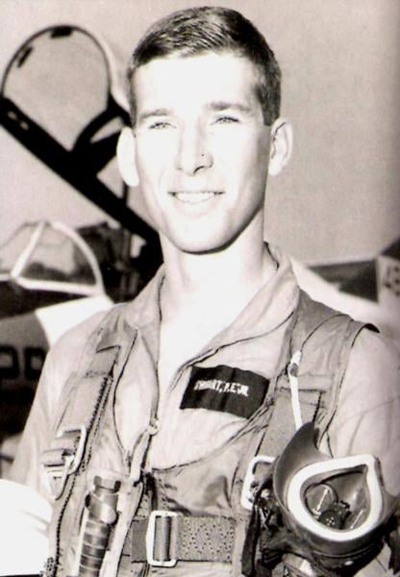
Any lack of awareness or inattention by either ship, especially at night, in extreme weather, or with battle damage, can put the plane guard ship under the bows of a rapidly maneuvering carrier traveling at full speed.
When Fletcher is not in plane guard station, we are miles ahead, or on either side of “Hanna,” fanned out with other destroyers of the carrier strike group.
We are “tin can” destroyer sailors who provide early warning screening, defense in depth, and search and rescue support to protect “Hanna” and her crew from harm.
It is 0203, early morning. Today, Fletcher is in plane guard station, 2,500 yards behind “Hanna.” It is pitch black, except for pinpoints of ship navigation lights.
I am standing the bridge watch on Fletcher when a Vought F-8H Crusader aircraft lands heavily on “Hanna’s” carrier deck and explodes in a huge orange fireball right in front of me.
At first light, we find pieces of fuel cells from the wing tanks, and a piece of a flight helmet, in the thinly scattered debris floating on the surface of the Gulf of Tonkin.
Lieutenant (junior grade) Paul Eugene Swigart, Jr., USNR, a pilot in Fighter Squadron 24 (VF-24) “Fighting Renegades,” Carrier Air Wing 21 (CVW-21), aboard USS HANCOCK (CVA-19), is killed. His body is not recovered. He is 25 years old.
LTJG Swigart is from Seal Beach, California. His MOS (Military Occupational Specialty) is Unrestricted Line Officer, Pilot (1315).
Earlier today, he flew from a base in South Vietnam to land on the flight deck of USS HANCOCK (CVA-19) on Yankee Station in the Gulf of Tonkin about 80 miles east of North Vietnam.
At Fort Rosecrans National Cemetery, San Diego, California, he is named on a memorial headstone in plot MA 0 105. His name is inscribed in the Courts of the Missing, Court B, National Memorial Cemetery of the Pacific, Honolulu, Hawaii.
His name, PAUL E SWIGART JR, is inscribed on the black granite Vietnam Veterans Memorial (Panel 33W, Line 69). His name is one of 58,307 names on “The Wall” in Washington, D.C.
Sunday, February 9, 1969
It is now four days later, 0604 in the morning. We are 125 miles east of North Vietnam. Fletcher is in screen station, five miles off the starboard beam of USS HANCOCK (CVA-19).
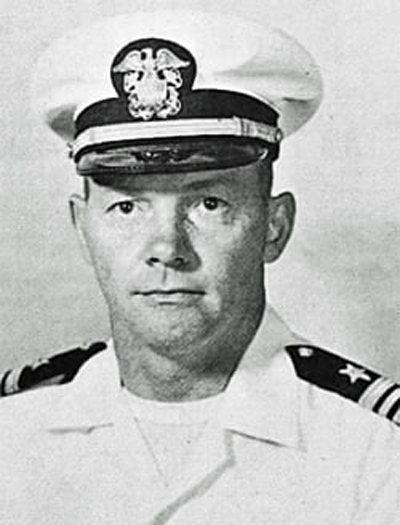
A Douglas A-4F Skyhawk from Hancock catches fire during the catapult shot, and crashes into the Gulf of Tonkin. As “Hanna” passes by, the pilot is seen inside his plane, sinking on the starboard side.
Fletcher assists in search and rescue operations in the wreckage area. We find two signal wands, part of the cockpit seat, and some insulation.
Lieutenant Commander Roger Allen Meyers, USN, a pilot in Attack Squadron 164 (VA-164) “Ghost Riders,” Carrier Air Wing 21 (CVW-21), aboard USS HANCOCK (CVA-19) is killed. His body is not recovered. He is 35 years old.
Lieutenant Commander Meyers is from Chicago, Illinois. His MOS (Military Occupational Specialty) is Unrestricted Line Officer, Pilot (1310).
At Arlington National Cemetery, Arlington, Virginia, he is named on a memorial headstone in Memorial Section 3. His name is inscribed in the Courts of the Missing, Court B, National Memorial Cemetery of the Pacific, Honolulu, Hawaii.
His name, ROGER A MEYERS, is inscribed on the black granite Vietnam Veterans Memorial (Panel 33W, Line 94). His name is one of 58,307 names on “The Wall” in Washington, D.C.
No one wants to be a Gold Star Family.
Gold Star Families remember their family members who have died in military service.
As a nation, we honor the ultimate sacrifice of Gold Star Families.
As human beings, we acknowledge the loss, the grief, the need for continual healing of Gold Star Families.
Men and women who die in military service give their last full measure of devotion to the people of the United States. They give the ultimate sacrifice of their lives for the rest of us.
The least we can do is remember them.
This day, I remember U.S. Navy Lieutenant (junior grade) Paul Eugene Swigart, Jr., USNR.
This day, I remember Lieutenant Commander Roger Allen Meyers, USN.
I was there. I remember.
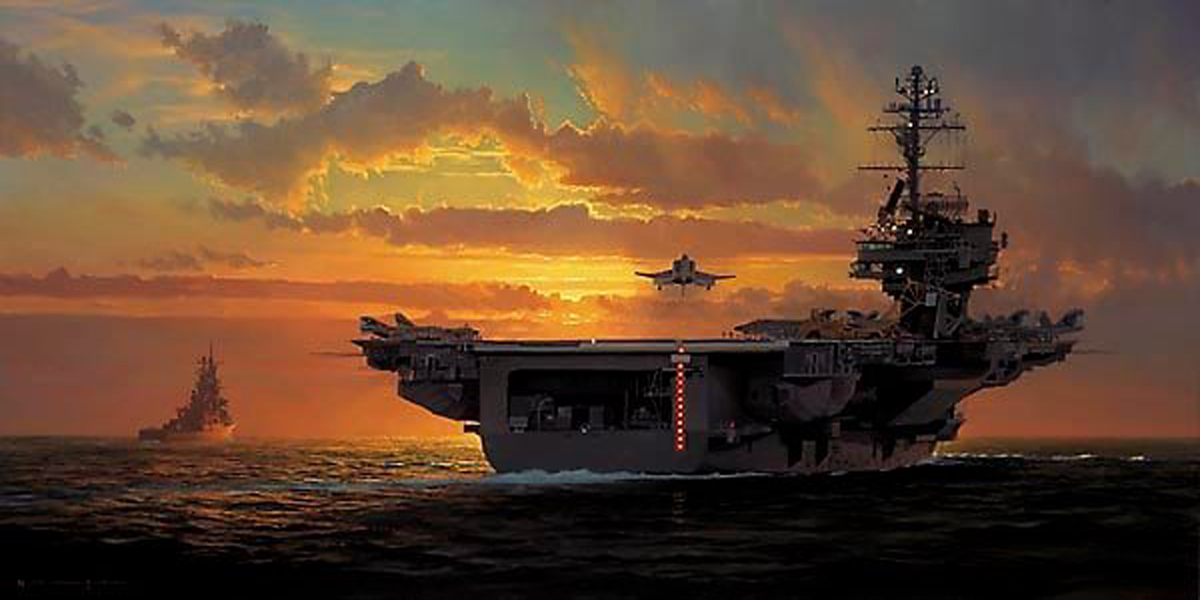
Military humor: Badge of the Tonkin Gulf Yacht Club -aka US 7th Fleet-
Tonkin Gulf Yacht Club was a tongue-in-cheek nickname for the United States Seventh Fleet during the Vietnam War . [1] All through the war in Vietnam , the Seventh Fleet engaged in combat operations against enemy forces through attack carrier air strikes, naval gunfire support, amphibious operations, patrol and reconnaissance operations and mine warfare.
History [ ]
The name "Tonkin Gulf Yacht Club " was used from 1961 when the Seventh Fleet arrived to the waters off Vietnam and carried out most of its operations from the Gulf of Tonkin. This included aircraft operations at Yankee Station and destroyers and cruisers along the coast on the gun line . After the 1973 cease-fire , the Fleet conducted mine countermeasure operations in the coastal waterways of North Vietnam . Two years later, ships and aircraft of the Fleet evacuated thousands of US citizens and refugees from South Vietnam and Cambodia as those countries fell to opposing forces. The fleet departed in 1975.
Although the insignia for the Tonkin Gulf Yacht Club always remained unofficial, it became very popular. It is present in a wide range of Vietnam War military memorabilia. The yellow and red background colors are those of the flag of the Republic of Vietnam .
References [ ]
- ↑ Tonkin Gulf Yacht Club
External links [ ]
- Official Seventh Fleet web site
- Roster of ships in the Tonkin Gulf Yacht Club
- Rene J Francillon, Tonkin Gulf Yacht Club US Carrier Operations Off Vietnam

Tales of an Asia Sailor
Crap, true and not, that has wandered through my mind..

Tonkin Gulf Yacht Club
By: Garland Davis

The novel and movie, “Mister Roberts” pictures life aboard a “bucket” that tiresomely traffics between the islands of Tedium and Apathy with side trips to Monotony.
This is my story of a WestPac at the end of the war in Vietnam. My ship also made those stops at Tedium, Apathy and Monotony. We also frequently visited Exhaustion and Total Exhaustion.
I reported into a Pearl Harbor-based Destroyer of DesRon 11 in early September of 1972 as a CS1. I was to be the leading cook. The CS2 I was relieving met me and my wife at the airport and carried us to our hotel. I never saw him again. He never returned to the ship. UA and eventually listed as a deserter.
I found a fucking mess when I reported aboard. There were no menus, no records of stores aboard, the chill reefer was full of sour milk and rotting vegetables, the freezer was a shambles, and the dry storerooms looked as if they had been stirred with a stick. No attempt had been made to load out for WestPac. The ship was leaving in ten days.
The galley was filthy and crawling with cockroaches. The cooks were cooking and serving whatever they could find. I went to talk with the Supply Officer and Assistant Supply Officer. I told them what I had found and what it was going to take to get ready to load stores. First I had to know what we had aboard before I could order and it was going to take a major evolution to empty and clean the reefers and salvage what I could. The storerooms would need to be emptied and cleaned and restocked. Then I could hold and inventory and get an order done.
I was thinking that it was a good thing I had sent my wife to Japan to stay with her family during the cruise. I would have seen very little of her during the days before we departed for WestPac.
The Supply Officer managed to get me a twenty hand working party of Sea Scouts who were aboard for two weeks. I worked those boy’s asses off. Within three days, I was able to get an inventory completed and an order done. Once I had accountability established and stores coming aboard, I turned my attention to the menu and the galley. I restricted all the cooks and mess cooks and after supper on Friday evening, we held field day in the Galley, Mess Decks, and Scullery. I was ready for WestPac two days early.
The morning we departed, two more CS’s and two mess cooks missed movement. I thought I was to do the entire cruise three cooks and two mess cooks short but a CS1 reported in Subic after a first short stint on the gun line.
About this time the North Vietnamese walked out of the Paris Peace Talks. This pissed Nixon off. We were en route to Hong Kong in early December when they turned us around and sent us to the Tonkin Gulf. Until the shooting stopped we were either sitting on station awaiting firing orders, chasing a carrier back and forth while they strove for nineteen over the deck, or ran into Haiphong harbor and shot up the shipping. With the exception of plane guard, it was shoot all night, rearm and refuel all day and get a little sleep if possible.
Being short of cooks in the galley and I was the only one who knew how to bake, I was working eighteen and twenty hour days overseeing the cooks and mess cooks during the day and baking half the night.
The whole crew walked around like zombies. A group of PO1’s took over my reefer decks for an evening crap game when possible. I don’t think there was a big winner. The game probably had five hundred bucks in it. They could have accomplished as much by making up a watch bill designating who was to hold the money on a particular day. They got pissed at my CS1 and me because he went down one night and won the money. He bought money orders and mailed it to his wife the next day. That pretty much ended the crap games.
We got a few days chasing the carrier. The tempo of rearming and refueling slowed down and we were able to get a little rest. A surprise, a CSSN was high lined over from the carrier with orders to us. Someone in the bureau had forgotten to let us know he was coming. He was an “A” School graduate and had a little baking experience. Took a load off me. Still had to help him, but didn’t have to do it all myself.
I had taken the advancement exams for CSC in February 1971. I had passed the test and was eligible for promotion, but my advancement had a Bureau Hold placed on it. I was investigated for cheating on the test. For over a year before I left North Island, I probably was in the ONI CID offices, at least, three times per week. Two men in civilian clothes, I later learned that they were both W-3’s, questioned me over and over.
They always started with, “Did you have prior knowledge of the questions on the advancement exam for Chief Commissaryman?”
This is where I let my smart mouth overload my dumbass, I would always answer with, “Yes!”
Of course their next question was, “How did you know what was on the test?”
Every time, I answered, “I studied.”
Now I don’t know how I did on the test. One of the investigators told me I aced it. The other said I missed one question.
Now we are on the gun line in February 1973, almost two years after I took the test. While my advancement was on hold, I was not permitted to take subsequent advancement exams.
It was shortly after supper and I am in the galley with the baker when the bridge passes, “Chief Petty Officer Davis lay to the bridge!” I knew they weren’t talking about me. I continued on with what I was doing. The BTC came to the galley door and said, “That’s you Dave, they want you on the bridge.” He handed me a green log book and said, “This will be your charge book.”
The first notation in my charge book was, “Appearing in front of the Commanding Officer in an improper uniform.” Signed Ray Harbrecht, CDR, USN. He also gave me a copy of a message that authorized advancing me to CSC effective May 16, 1971.
The Chiefs scrounged enough uniforms for me to get through a few days until I was high lined to the Ranger where I was able to purchase work khakis and brown shoes. I filled out my sea bag when we finally got to Subic.
I locked horns with the XO a couple of time over steel beach cookouts. He was determined that a steel beach was the best way to improve morale on the gun line. Every time he planned one, something happened to cancel it. Twice we cooked steaks in the galley instead of on deck. The third time he planned one, I told him that I was out of steak. He said order more. When I tried to explain to him that beef was ordered in units and for every case of steak, you had to take four cases of ground beef, two cases of oven roast, two cases of pot roast, and etc. He got mad at me and told me he would get the steak. He ordered eight cases. We ended up with three pallets of beef and no room to store it. We transferred it to the carrier along with the steak. The Supply Officer told me that he was telling the Wardroom that I didn’t explain the rudiments of ordering beef to him.
While on the gun line the XO, would walk around the ship between rearming or refueling evolutions and then call the Officers and Chiefs and chew us out because people were sleeping. He would then have the word passed, “All Hands Turn to, Titivate the Ship!”
The Senior Chief Fire Controlman took a lot of the XO’s wrath off me. He had Narcolepsy and was retired after we returned to Pearl. He could fall asleep between spoonsful of soup. The XO would get mad at him for sleeping while he was talking. He sent him for evaluation in Subic and he was flown to Pearl. We had a retirement ceremony for him after we returned. Of course he slept through it.
About the time we arrived in Hawaii, my CS1 learned that he had made CSC and would be frocked to Chief on August 16. The ship was told to transfer either of us to one of the Tankers homeported in Hawaii. I had barely started the planning to bring my wife from Japan to Pearl when the Supply Officer told me that the XO was adamant that I be the one to go to the tanker.
I told the Supply Officer, “All you guys are going to do is get inspected right and left and told that you are not ready to fight the war that we just fought. The AO is leaving for WestPac next week. I’ll take WestPac over that bullshit any day. As a friend of mine said, when the SubPac detailer threatened to send him to a diesel boat home ported in Subic, ‘Master Chief, throw me in that fuckin’ briar patch’”
And that is how I made Chief. Probably would have made Senior and Master Chief, but I never learned to prevent my smart mouth from putting too much of a load on my dumbass.
Share this:
One thought on “ tonkin gulf yacht club ”.
Another great sea story Garland. Thanjavur.
Navy Yacht Clubs, Seas and Station patches

By Patchcollector, October 15, 2011 in NAVY, COAST GUARD AND OTHER SEA SERVICES PATCHES
Recommended Posts
Patchcollector.
Happy Saturday all,here is my Navy "Yacht Club" collection.
Over the years I have picked up a few of the original Tonkin Gulf ones,in various sizes and shapes,and every now and then,would see one from other places,so I decided to try and collect as many different ones as possible.
This first pic is a front view,group shot of my Tonkin Gulf patches
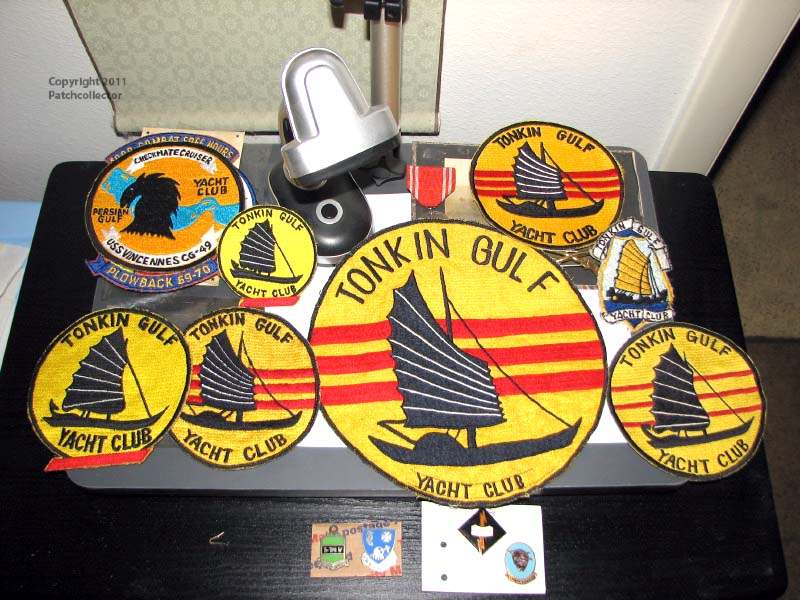
Link to comment
Share on other sites.
A rear view,group shot of my Tonkin Gulf patches,all made in Japan,I believe
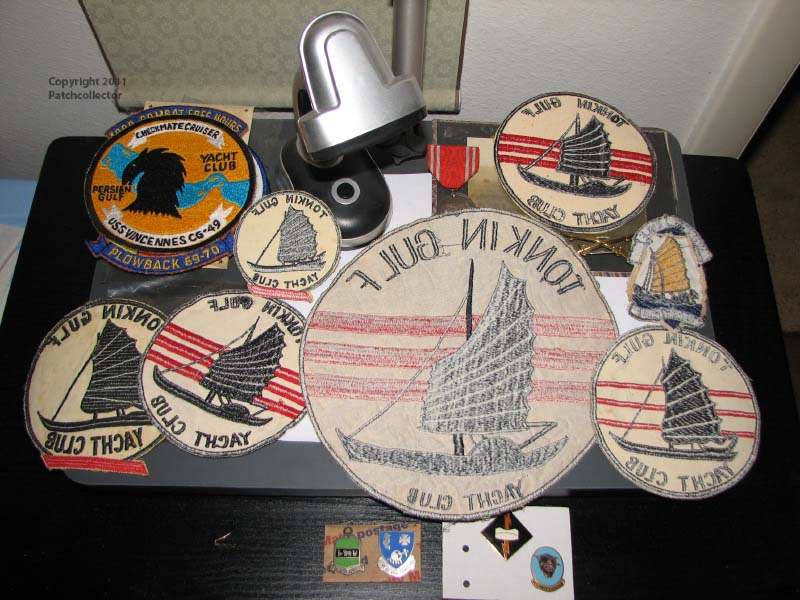
My BIG Tonkin,a back patch
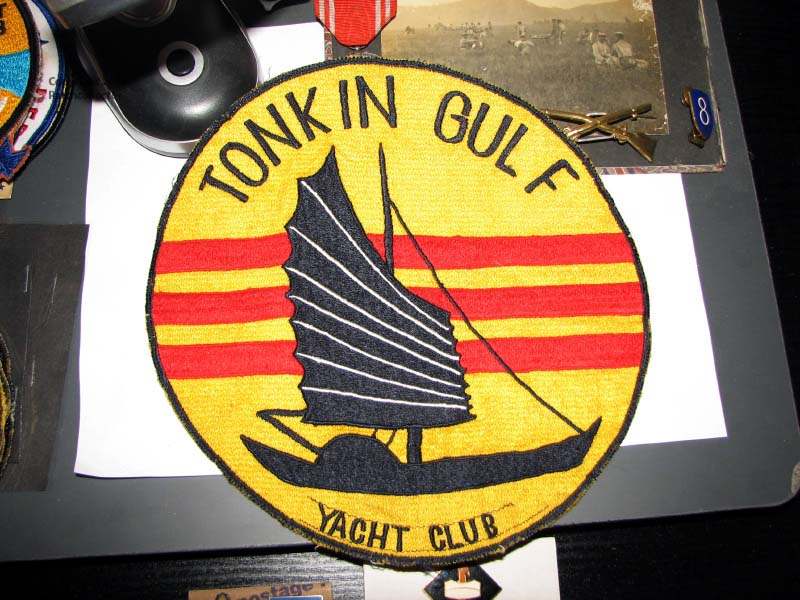
Rear view of the back patch
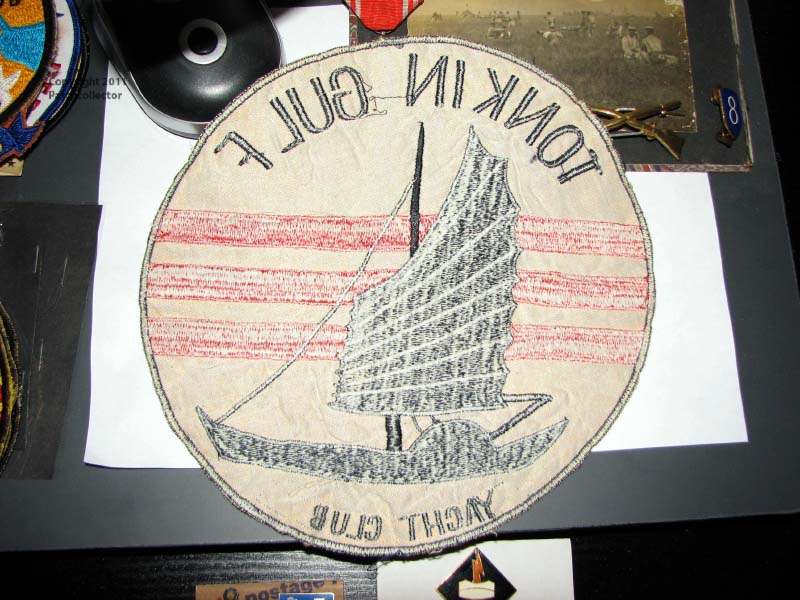
A nice minty medium sized example
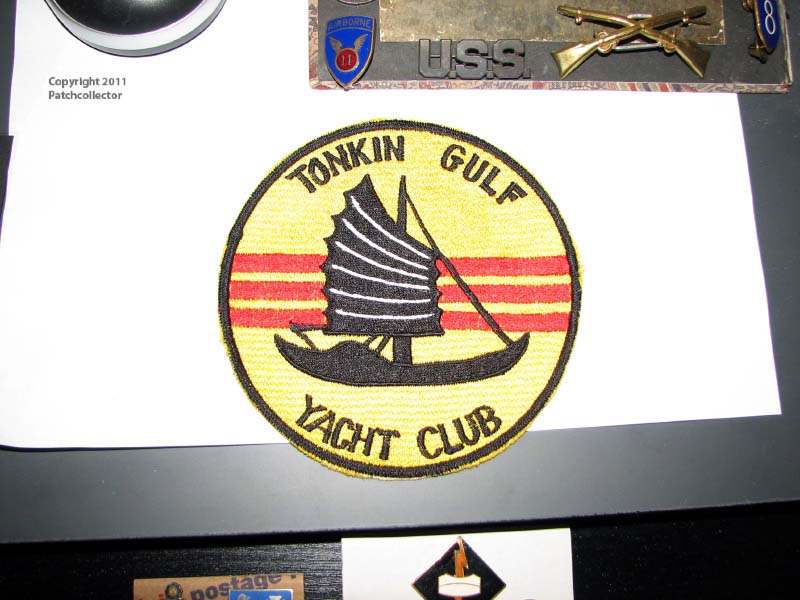
Another,if you look closely,you can find subtle differences in the boat shape,and other design elements
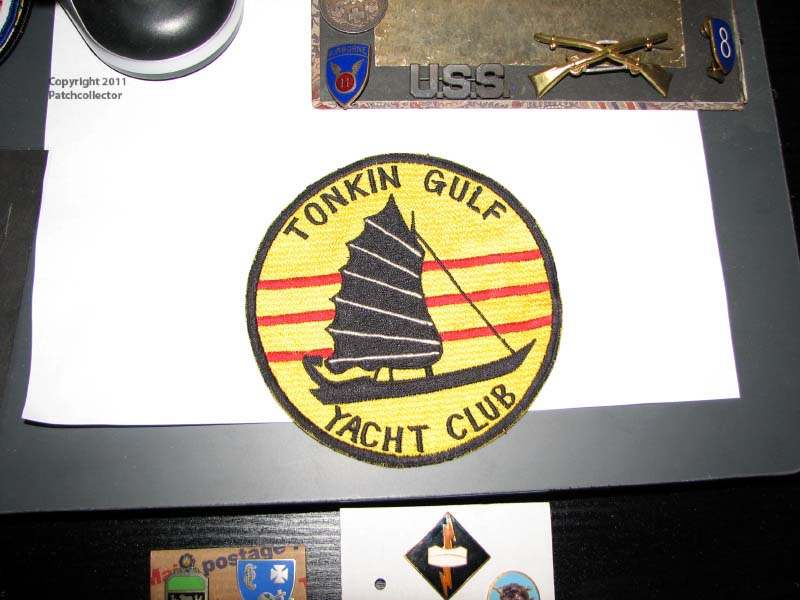
Here is a variation that has a red bar underneath the disc,it means that this is the second tour for the buyer of this patch
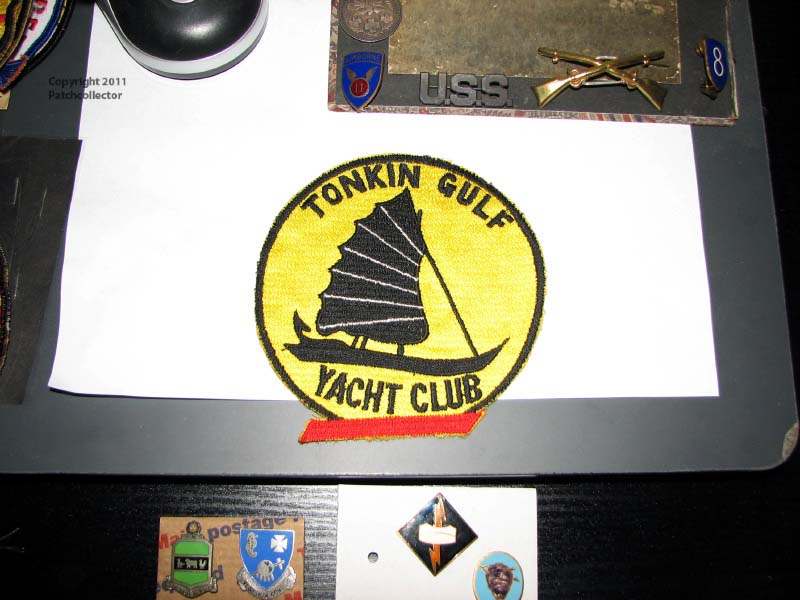
Another one,a bit bent!
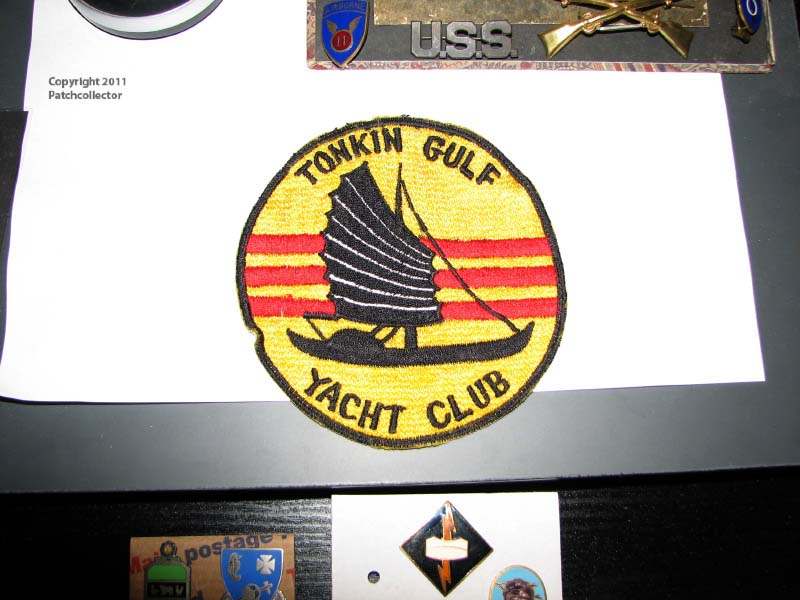
A smaller second tour patch
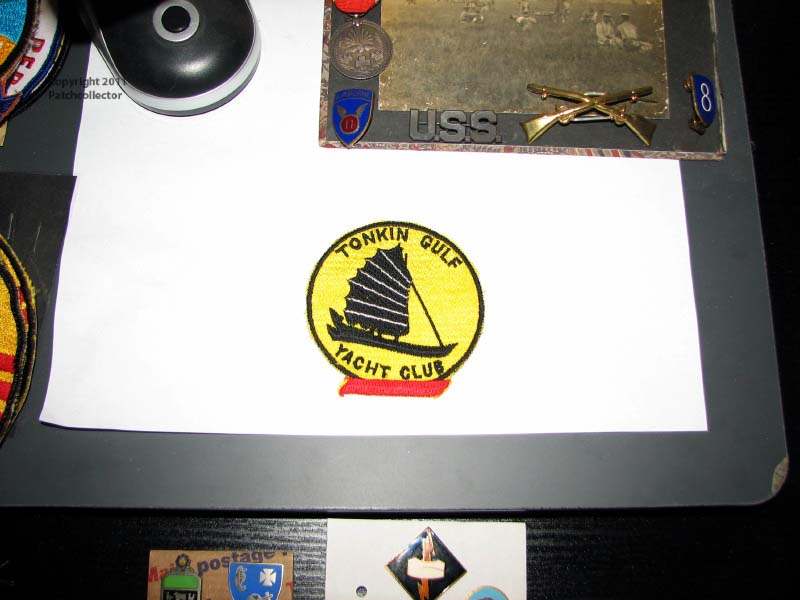
Here is a recent addition to my collection,this one is shaped differently than the other standard designs.
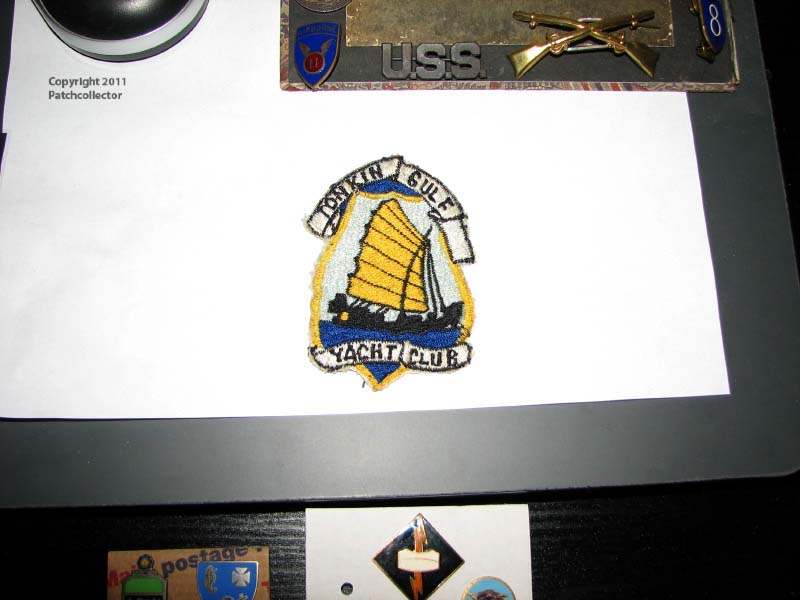
Nice collection of variants. So where would these patches be displayed...on USN tour jackets/party suits etc?
Now after the Vietnam war,other Naval units picked up on the "Yacht Club" theme,so here are some ones from other parts of the world.Some are personalized to individual ships.First up,a Persian Gulf Yacht Club for the Cruiser Vincennes.
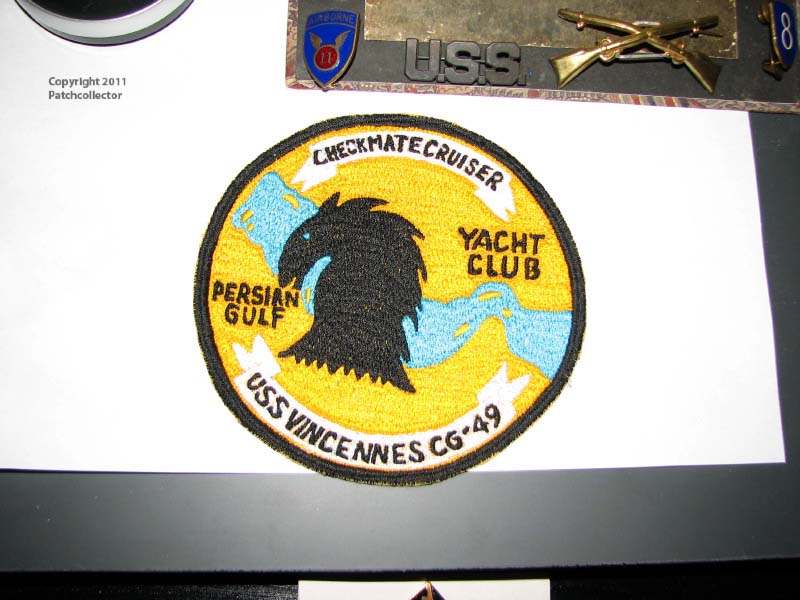
Back,looks P.I made.
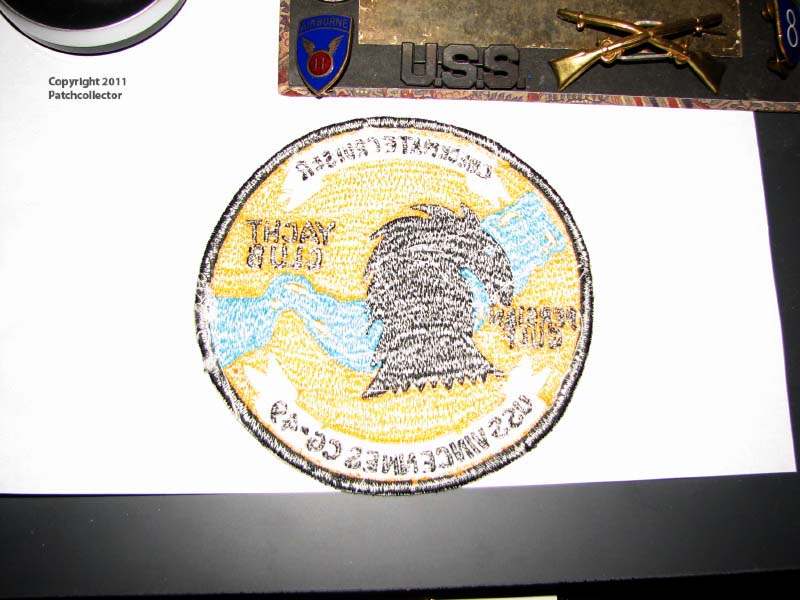
Here is an Eastern Mediterranean Yacht Club.Notice the Jewish star and Egyptian pyramid!
I've seen this patch as an Ace Novelty item,I think that the tag was removed from the back.
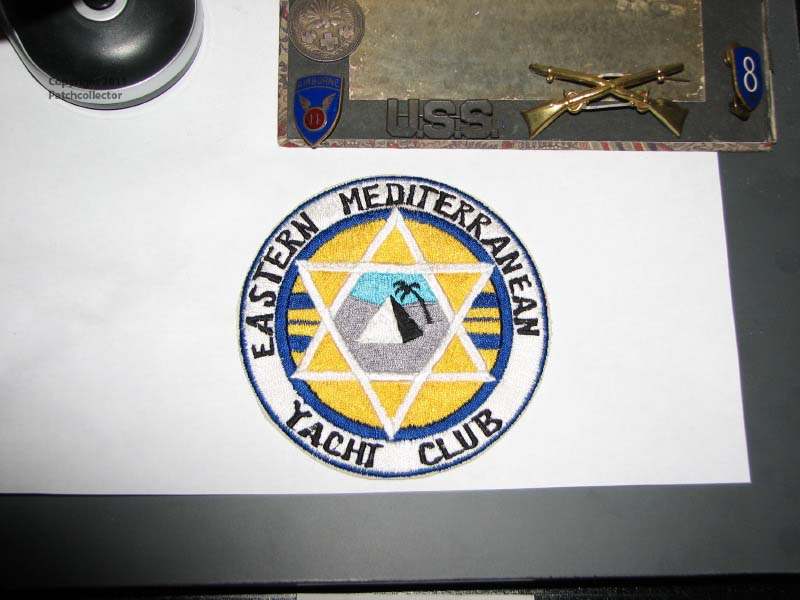
Next is the Gulf of Sidra,Libya,when the US sank some ships from that country.Libya is back in the news again!
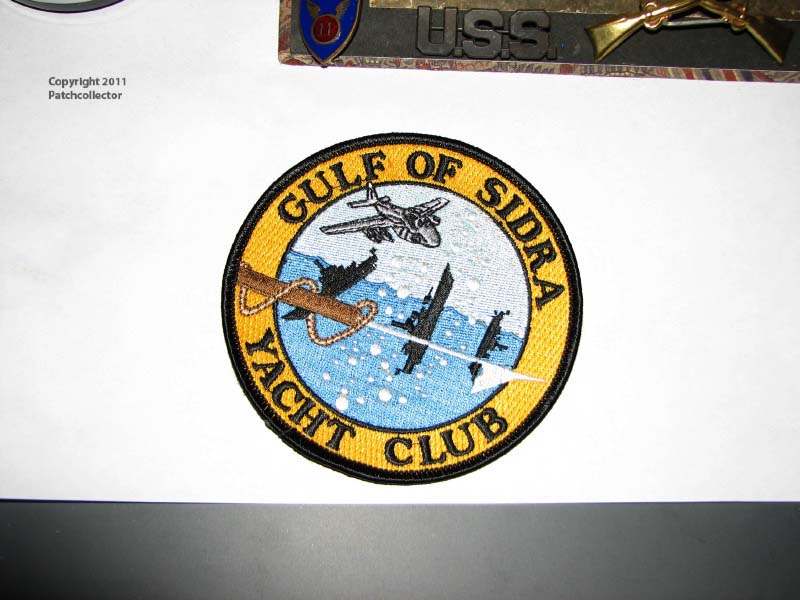
Here is a Mediterranean Yacht Club,this one is for the carrier Nimitz,and is dated 1983
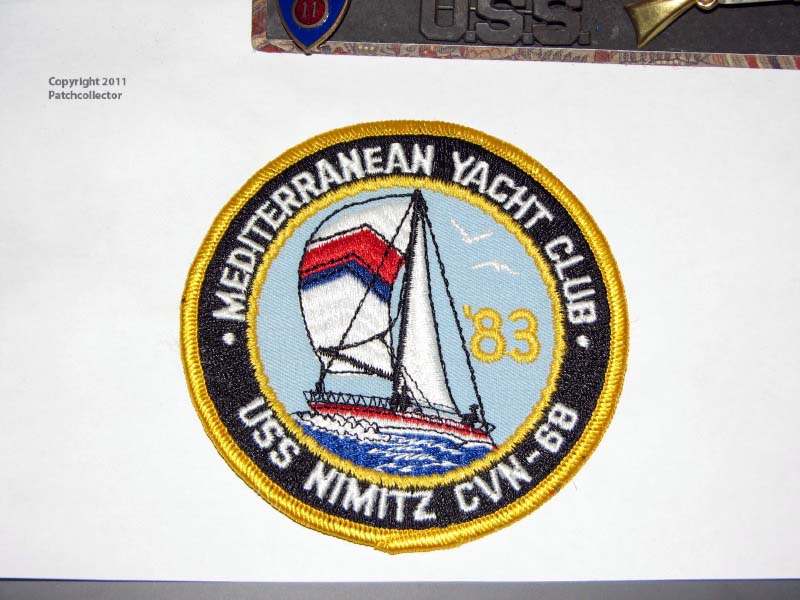
In 1984 the USS King sailed in the Persian Gulf,and a Yacht Club patch was made for this "War Zone" cruise
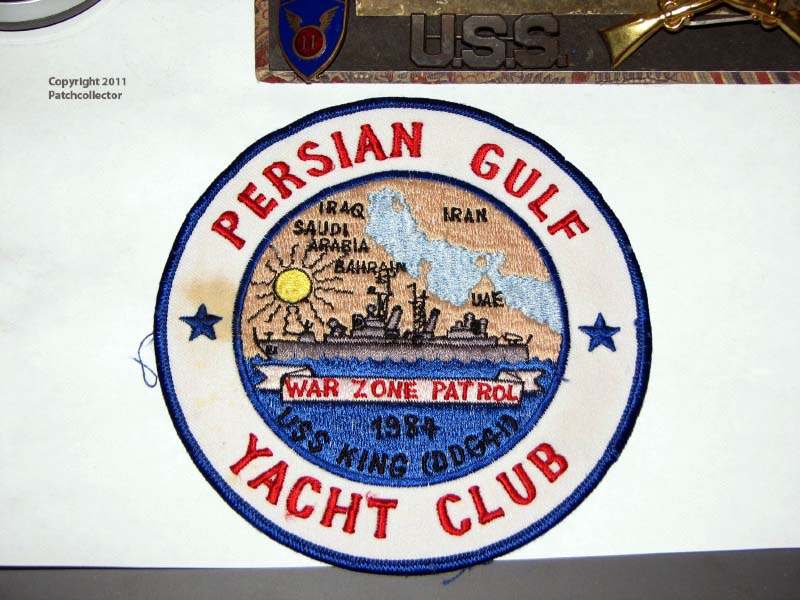
Here is an unusual on that I picked up recently,for the Spratley Islands
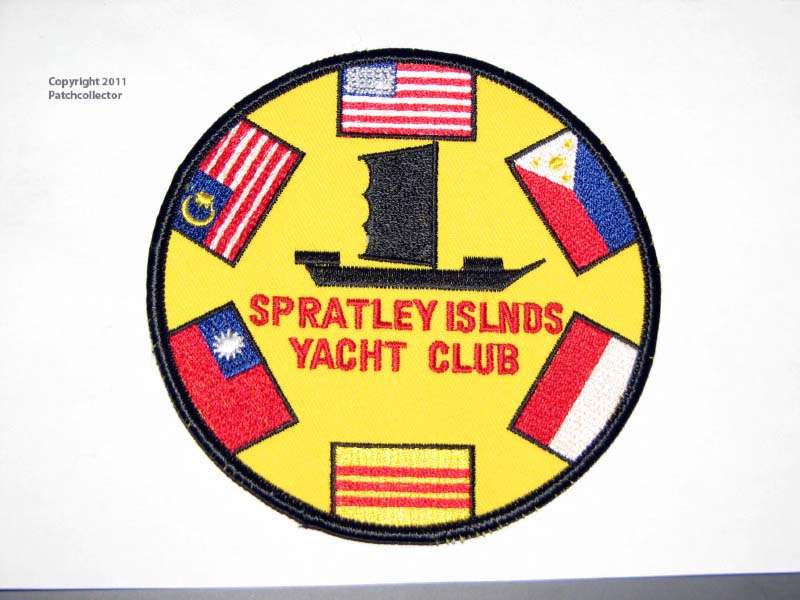
Back,made in Japan,I think
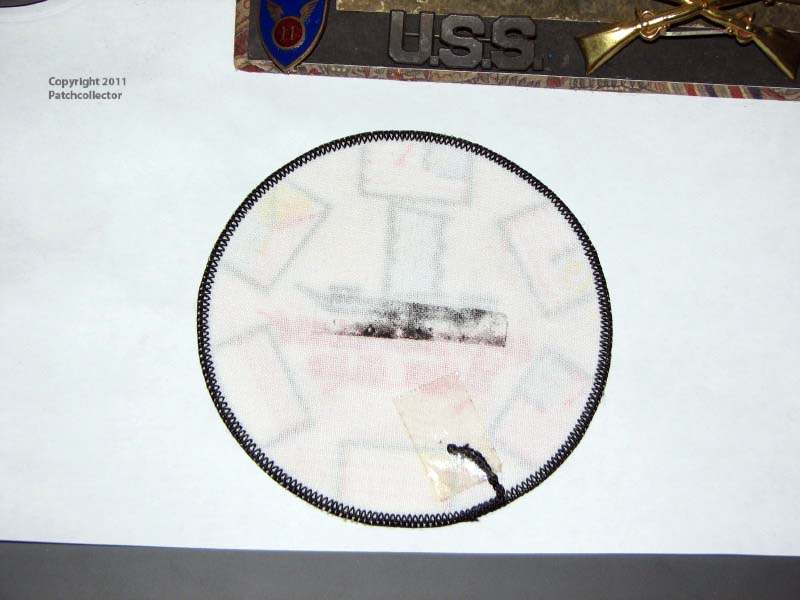
Thanks Sabrejet!Yes these would be for jackets,or suits,if they had them.
Here is an interesting one,I did some research into Operation Plowback,and it was a training OP for pilots going to Nam.A little humor never hurts!
I found this image on a website.It appears that my patch has an error.It should read "Mexico"

Here are my Viet era yacht patches. All Japanese made and quite remarkably all 8 are different than the ones PC posted.
Regards, Mitch
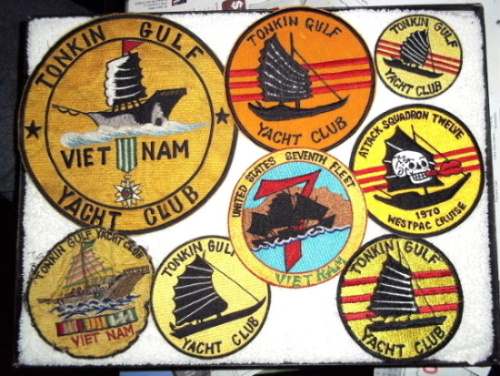
Here are my Viet era yacht patches. All Japanese made and quite remarkably all 8 are different than the ones PC posted. Regards, Mitch
Awesome patches Mitch! :bravo: You have some sweet variations!I love the detailed boats on the patches to the left.
The center one is cool because it identifies the 7th Fleet,and the Attack Squadron 12 is,I believe,a scarce variation!
- 2 weeks later...
Here is a patch for the USS Charles E. Brannon,a Destroyer Escort.
I am including it in my Yacht Club collection because she may have
been one of the first US Navy ships to participate in the Tonkin area,
at a very early stage of the hostilities in Vietnam.Notice on the patch
an image of the familiar "Junk",seen on later Gulf of Tonkin Yacht Club
Patches!Sorry about the small pics,they are the sellers,not mine.
Here is her story:
After seeing action in WW2,she joined the Reserve Training Fleet,providing Reservists with hands on experience.In 1962 however,she was part of CORT DIV. 72(Escort Division 72),and while on this Pacific cruise,proceeded to Vietnam,assisting in training units of the South Vietnamese Navy,and also "showing the flag",maintaining American presence in that area.She then screened the Valley Forge (LPH-8), Navarro (APA-215), and Point Defiance (LSD-31) while that group took a Marine Corps expeditionary force to Bangkok,Thailand.The 3rd Battalion,9th Marines, embarked in the amphibious group were sent to Thailand in an effort to provide the friendly regime with troops to deter any Communist moves across the Mekong River.
DE-446 DEPLOYMENTS - MAJOR EVENTS
Add a DE-446 Shellback Initiation Add a DE-446 Deployment - Major Event
Month Year to Month Year Deployment / Event
FEB 1945 - - - Shellback Initiation - 15 FEB 1945 - Pacific Ocean
JAN 1961 - JAN 1962 Middle Pacific
JAN 1962 - JAN 1963 VIETNAM
DANFS History of DE 446
Charles E. Brannon, who was born 2 August 1919 in Montgomery, Alabama, enlisted in the Naval Reserve 14 April 1941 for aviation training. Ensign Brannon reported for duty in Torpedo Squadron 8 in carrier USS Hornet (CV-8 ) 3 February 1942, and was killed in action 4 June 1942 during the Battle of Midway. He was awarded a Navy Cross posthumously for his extraordinary heroism in pressing home an attack against a Japanese carrier.
( DE-446: displacement 1,350; length 306'; beam 36'8"; draft 9'5"; speed 24 knots; complement 186; arms: 2 5" turret guns; 2 twin 40mm guns; 10 20mm guns; 3 21" torpedo tubes; 8 depth charge projectors; 1 depth charge projector-hedgehog; 2 depth charge tracks; class: John C. Butler)
Charles E. Brannon (DE-446) was launched 23 April 1944 by Federal Shipbuilding Company, Newark, New Jersey; sponsored by Second Lt. D. Brannon, WAC; and commissioned 1 November 1944, Comdr. E.W. Todd in command.
Putting out from New York 27 January 1945, Charles E. Brannon escorted cargo ships by way of the Panama Canal, and the Galapagos and Society Islands to Manus, arriving 15 March. Routed on to San Pedro Bay, Philippine Islands, she began the important task of guarding inter island convoys. Late in April, she sailed in the screen of the assault forces bound for Tarakan, Borneo, off which she lay from 1 to 8 May, covering the landings and giving call fire support. Her effective gunfire won many compliments from the troops whose advance was thereby expedited. Charles E. Brannon gave similar support during the assault on Brunei Bay which began 10 June.
From beginning of July through mid-September 1945, Charles E. Brannon escorted convoys sailing from the Philippines to Okinawa, then participated in the occupation of China operating between Okinawa and Hong Kong. She returned to San Francisco 1 February 1946, and on 21 May 1946 was placed out of commission in reserve at San Diego.
From August 1946 into 1960, Charles E. Brannon was assigned to the reserve training program. In cruises along the west coast over weekends and in more extended periods, active reservists manned her in refresher training. From 21 November 1950 to 18 June 1960, Charles E. Brannon performed this service in commissioned status, and since the latter date has been in service under an officer-in-charge, with a reserve officer in command when she puts to sea with her reserve training group, until she was decommissioned in 1968. In 1969 she was sold for scrap.
Charles E. Brannon received one battle star for World War II service.
CHARLES E. BRANNON (DE-446)
Named for Ensign Charles E. Brannon, b. 2 August 1919, Montgomery, AL; served with Torpedo Squadron 8, HORNET (CV-8); KIA 4 June 1942, Battle of Midway; posthumous Navy Cross
Builder: FED
Keel laid 01/13/44
Launched 04/23/44
Commissioned 11/01/44
First CO: Cdr E. W. Todd
Decommissioned 05/21/46; one battle star
Recommissioned 11/21/50-06/18/60
Stricken 09/23/68
Sold 10/27/69, scrapped
Unit of CortDiv 77
From the research of Anne McCarthy,
with contributions by Pat Perrella and Pat Stephens, webmaster. March 2006
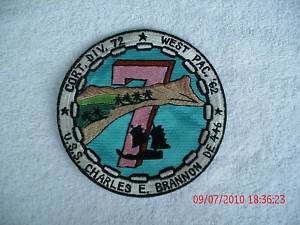
I love these. Wish I still had mine. Ian, we wore these on our Dungaree working Jackets, Cruise Jackets (tour jackets?) and sometimes on Foul Weather Jackets (Deck Jackets) if we could manage to hang on to one. Airdales would wear them on flight jackets. Not sure what a "Party Suit" is. Never saw/heard of anything like that.
Steve Hesson
I love these. Wish I still had mine. Ian, we wore these on our Dungaree working Jackets, Cruise Jackets (tour jackets?) and sometimes on Foul Weather Jackets (Deck Jackets) if we could manage to hang on to one. Airdales would wear them on flight jackets. Not sure what a "Party Suit" is. Never saw/heard of anything like that. Steve Hesson
Steve,a party suit is the Air Force equivalent to a cruise jacket,except it is a one piece,like a flight suit.Sometimes two piece party suits were made as well.
Worn at casual functions,like after work parties,hence the name.
Here is some info I found online:
Party suits were a local and unofficial creation that arose in 1967 from the 357th Tactical Fighter Squadron of the 355th Tactical Fighter Wing, stationed at Tahkli Royal Thai Air Base. They created "special flight suits" in response to the 8th Tactical Fighter Wings' usage of black dyed cotton flight suits for social occasions. The use of these colorful, lightweight suits, popularly known as "Party Suits," was soon adopted by the Air Force flying units stationed at the large bases in Thailand. The tradition also quickly spread to units in South Vietnam and to a limited degree, other locations in Southeast Asia. Party suit usage was normally limited to flight personnel and those in direct support of flight operations.
Party suit colors were consistent within the unit and generally had some standard form of name, rank and unit identification. Additional insignia, unofficial patches (usually humorous) and other embroidery was purely up to the creativity of the individual. There were numerous local tailors near the air bases who specialized in making party suits and embroidering the many associated custom patches.
The light and comfortable suits were ideal in the tropical environment and were worn on-base only for special social occasions in lieu of official dress uniforms, which were not commonly used in Southeast Asia. The most significant social occasion was the famous "Sawadee" party. Named for the Thai language greeting appropriate for both "hello" and "good-bye," this party welcomed newly arrived personnel and bid good-bye to those returning home.
The party suit tradition, although superficially humorous, served an important role in Air Force organizations by promoting unit integrity and maintaining an esprit de corps under the most difficult combat circumstances, while being highly valued by those who served in Southeast Asia.
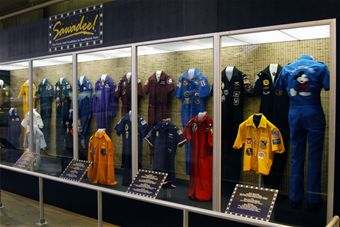
Steve,a party suit is the Air Force equivalent to a cruise jacket,except it is a one piece,like a flight suit.Sometimes two piece party suits were made as well. Worn at casual functions,like after work parties,hence the name. Here is some info I found online: Party suits were a local and unofficial creation that arose in 1967 from the 357th Tactical Fighter Squadron of the 355th Tactical Fighter Wing, stationed at Tahkli Royal Thai Air Base. They created "special flight suits" in response to the 8th Tactical Fighter Wings' usage of black dyed cotton flight suits for social occasions. The use of these colorful, lightweight suits, popularly known as "Party Suits," was soon adopted by the Air Force flying units stationed at the large bases in Thailand. The tradition also quickly spread to units in South Vietnam and to a limited degree, other locations in Southeast Asia. Party suit usage was normally limited to flight personnel and those in direct support of flight operations. Party suit colors were consistent within the unit and generally had some standard form of name, rank and unit identification. Additional insignia, unofficial patches (usually humorous) and other embroidery was purely up to the creativity of the individual. There were numerous local tailors near the air bases who specialized in making party suits and embroidering the many associated custom patches. The light and comfortable suits were ideal in the tropical environment and were worn on-base only for special social occasions in lieu of official dress uniforms, which were not commonly used in Southeast Asia. The most significant social occasion was the famous "Sawadee" party. Named for the Thai language greeting appropriate for both "hello" and "good-bye," this party welcomed newly arrived personnel and bid good-bye to those returning home. The party suit tradition, although superficially humorous, served an important role in Air Force organizations by promoting unit integrity and maintaining an esprit de corps under the most difficult combat circumstances, while being highly valued by those who served in Southeast Asia.
WOW. Trying to imegine a Sailor wearing something like that :think: . Most likely, get beat up. :w00t:
sigsaye said: WOW. Trying to imegine a Sailor wearing something like that :think: . Most likely, get beat up. :w00t: Steve Hesson
And What the h*ll is that sailor doing???? :w00t:
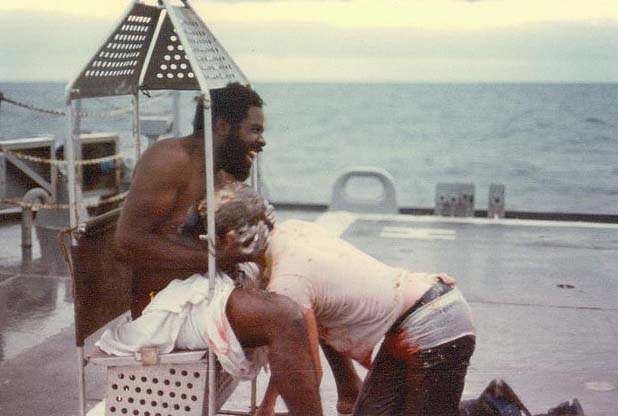
OK,OK,that's it,I'll quit there,'nuff said!
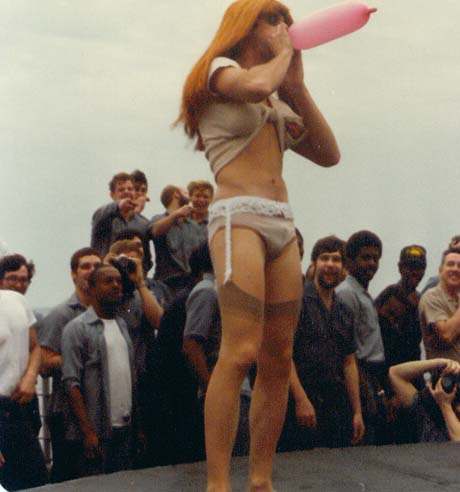
I think that "lady" has a pollywog in her panties!!! OK,OK,that's it,I'll quit there,'nuff said!
Seriously though, the explination makes complete sense. I had just never heard/seen one, so had no idea what they were. I guess just like Crossing The Line for the Navy/MC, Party Suits are an Air Force thing. neat patches though
HEHEEH That's just good fun Which brings up an interisting thing about Crossing The Line. The first time I went across, we did not know we were going. We just sort of got orders due to some incident in the south and were diverted from where we were originally going. But, when we had the Poly Wog Queen contest, All sorts of "Things not issued in a Male Seabag" showed up :think: May be those guys would have worn one of those "Party Suits" if thsy thought they could get away with walking down the street in one Seriously though, the explination makes complete sense. I had just never heard/seen one, so had no idea what they were. I guess just like Crossing The Line for the Navy/MC, Party Suits are an Air Force thing. neat patches though Steve Hesson
Well, I never was in the Wog Queen contest either, but did Kiss the Royal Babys Belly :w00t:
and he's wearing his underwear outside of his pants!! :w00t:
So that's what he is doing,that is one big baby That poor guy looks like he has crap smeared all over him, and he's wearing his underwear outside of his pants!! :w00t:
Yes, the Royal Baby was the fattest Shellback. yes, skivvies were worn on the out side, all other clothing was to be worn inside out. Different crossings had different rules. Yes, the Baby has much grease smeared all over his belly, and the wog is covered in about a weeks worth of galley garbage, old grease and assorted other "Stuff". Fun times. My son just informed me that one of the "training" lectures he had to give was "Why Crossing The Line Ceromoneys were a bad thing". Said he couldn't really think of anything, so just repeated the party line for 30 minutes. He was a shore duty type, nothing better to do I guess. Always semed like a waste of an enlistment to me.
Yes, the Royal Baby was the fattest Shellback. yes, skivvies were worn on the out side, all other clothing was to be worn inside out. Different crossings had different rules. Yes, the Baby has much grease smeared all over his belly, and the wog is covered in about a weeks worth of galley garbage, old grease and assorted other "Stuff". Fun times. My son just informed me that one of the "training" lectures he had to give was "Why Crossing The Line Ceromoneys were a bad thing". Said he couldn't really think of anything, so just repeated the party line for 30 minutes. He was a shore duty type, nothing better to do I guess. Always semed like a waste of an enlistment to me. Steve Hesson
Oh...man....a weeks worth of galley garbage, old grease and assorted other "Stuff"...I'm not gonna ask what the other "stuff" was,but I can guess... :pinch:
- 1 year later...

Here is an Ace Novelty patch I bought while onboard the USS Independence in 1983.
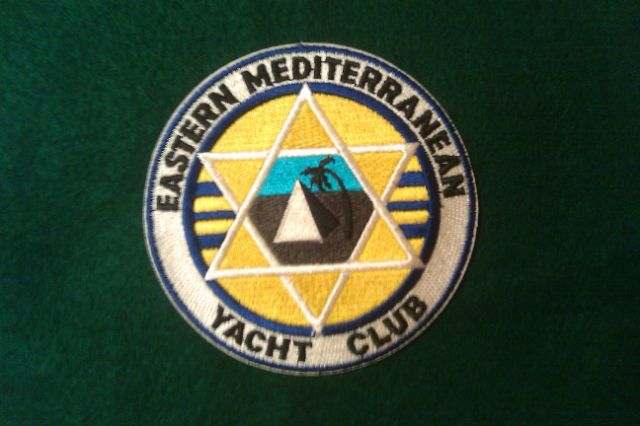
firefighter
Great collection of Yacht patches.I'll have to post some of mine, when I figure out my camera and when I figure out where to crop/size my images.The Easter-Med made by Ace is beautiful, even tho I'm a Vietnam collector.

Cool thread! Here is my variant of the Gulf of Mexico patch, which reads Flight Instructor on bottom.
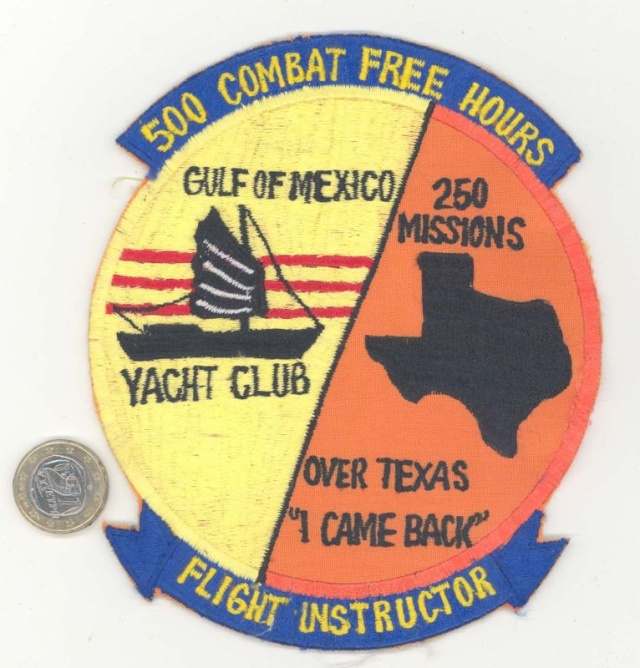
I have read somewhere that the Tonkin Gulf Yacht Club was the nickname of the Seventh Fleet. But also that it was worn by pilots who had to eject over the Tonkin Gulf; is there any truth to that?
Also, what does the bottom red stripe mean? It appears quite rarely on the classic patch design, is it for a second Westpac cruise?
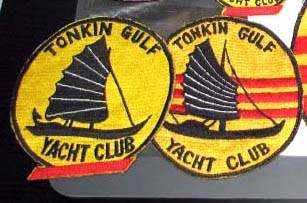
That patch was designed by a friend of mine during our '88 deployment to the PG. We had a contest aboard ship (sponsored by our CO) to design a "cruise patch" that embodied our time in the region. The crew voted on the submissions with the one being selected getting made in large quantities and sold in the ship's store.The winning artist would receive a handful of his patch, free of charge and the pride knowing his selection was the selected.
This patch was NOT the winner, however the skipper decided to have all of the entrants made up anyway so this one got produced in small quantities. I have one of each example (including my own submission).
One other patch design submitted by another shipmate also borrowed on the Yacht Club theme. This one has been reproduced a few times - I think that the manufacturer in the PI continued to manufacture it as it was so generic.
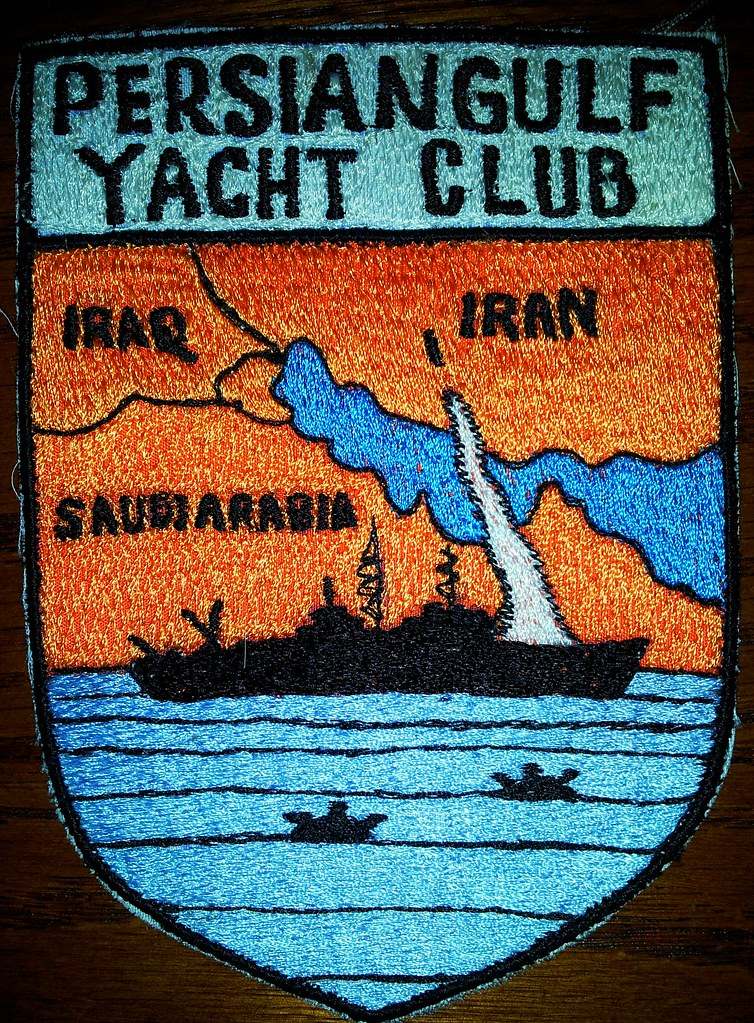
Cool thread! Here is my variant of the Gulf of Mexico patch, which reads Flight Instructor on bottom. I have read somewhere that the Tonkin Gulf Yacht Club was the nickname of the Seventh Fleet. But also that it was worn by pilots who had to eject over the Tonkin Gulf; is there any truth to that? Also, what does the bottom red stripe mean? It appears quite rarely on the classic patch design, is it for a second Westpac cruise?
Create an account or sign in to comment
You need to be a member in order to leave a comment
Create an account
Sign up for a new account in our community. It's easy!
Already have an account? Sign in here.
- Existing user? Sign In
- All Activity
- Moderator's Guide
- Advertisers
- Create New...

- Kindle Store
- Kindle eBooks

| Digital List Price: | $17.60 |
| Kindle Price: | $9.99 Save $7.61 (43%) | Amazon.com Services LLC |
Promotions apply when you purchase
These promotions will be applied to this item:
Some promotions may be combined; others are not eligible to be combined with other offers. For details, please see the Terms & Conditions associated with these promotions.
Audiobook Price: $17.18 $17.18
Save: $9.69 $9.69 (56%)
Buy for others
Buying and sending ebooks to others.
- Select quantity
- Buy and send eBooks
- Recipients can read on any device
These ebooks can only be redeemed by recipients in the US. Redemption links and eBooks cannot be resold.

Download the free Kindle app and start reading Kindle books instantly on your smartphone, tablet, or computer - no Kindle device required .
Read instantly on your browser with Kindle for Web.
Using your mobile phone camera - scan the code below and download the Kindle app.

Image Unavailable

- To view this video download Flash Player
Follow the author

The Tonkin Gulf Yacht Club: Naval Aviation in the Vietnam War Kindle Edition

- Print length 498 pages
- Language English
- Sticky notes On Kindle Scribe
- Publisher Osprey Publishing
- Publication date October 14, 2021
- File size 6465 KB
- Page Flip Enabled
- Word Wise Enabled
- Enhanced typesetting Enabled
- See all details
Customers who bought this item also bought

Editorial Reviews
“The Vietnam War was my war, by which I mean I fought in it, and I can say that Thomas Cleaver in his Tonkin Gulf Yacht Club examines the war in an unparalleled way through the lens of aviation and its aviators. He illustrates the inevitable agony and sacrifice, thrill and triumph of the young men immersed in that saga. It all makes for a riveting read.” - Colonel Lawrence Wilkerson, US Army (Ret.), soldier, diplomat and late Professor of Government and Public Policy at the College of William and Mary “Tom Cleaver has captured the dramatic history of Naval Aviation’s combat record in Vietnam in a manner worthy of the classic historical novel. From the first shot fired in the Tonkin Gulf in August 1964 to the final salvo in January 1973, Tom weaves an accurate tale, full of the color and fury of battle, courage, suspense, and thrill of victory – as experienced and portrayed on both sides of the conflict.” - Captain Roy Cash, Jr., USN (Ret.), Former CO, Top Gun “Tom Cleaver’s book is a superb study of Naval Aviation's experiences during the Vietnam War. Tom’s in-depth focus and analysis of personal inputs from aircrews on both sides of the conflict coupled with the ever-changing political environment make it a high-powered book that is difficult to put down.” - Rear-Admiral James A. “Jim” Lair, USN (Ret.), former commanding officer, USS America “With equal measures of aeronautical detail, historical perspective, and gripping action, Tom Cleaver has crafted an authoritative and balanced account of the Navy’s Vietnam air war. Readers will be amazed by the recall and revelations of the Naval Aviators interviewed, profiled and portrayed. This is a gripping narrative combined with a definitive historical and technical reference.” - David Sears, author of 'Such Men as These: The Story of the Navy Pilots Who Flew the Deadly Skies over Korea' “The author does an outstanding job of highlighting both the shortcomings and triumphs of naval aviation during this period.” - New York Journal of Books
About the Author
Product details.
- ASIN : B08W572RQV
- Publisher : Osprey Publishing; 1st edition (October 14, 2021)
- Publication date : October 14, 2021
- Language : English
- File size : 6465 KB
- Text-to-Speech : Enabled
- Screen Reader : Supported
- Enhanced typesetting : Enabled
- X-Ray : Enabled
- Word Wise : Enabled
- Sticky notes : On Kindle Scribe
- Print length : 498 pages
- #373 in Military Aviation History (Kindle Store)
- #397 in Vietnam War History (Kindle Store)
- #435 in Military Naval History
About the author
Thomas mckelvey cleaver.
My mother used to enjoy telling people that my first word was "airplane" (said as "o-pane") when a P-38 flew over the park we were in there in Denver, Colorado, where I grew up. My enjoyment of airplanes was also the result of my father's influence. He had worked for Roscoe Turner and met such luminaries as Ernst Udet and Jimmy Doolittle back in the 1930s. The fact my grand nephew can, at age 5, identify all the airplanes that live at the little airport across the street from his school I take as evidence that aeronuttiness is likely genetic.
Having learned to read at an early age, one of my favorite childhood activities was spending a Saturday in the stacks at the main Denver public library, going through the aviation and second world war history sections and devouring everything there. I also spent three years in the Navy in naval aviation as an enlisted sailor in the years immediately prior to and during the outbreak of that waste of 58,000 American lives and God knows how many Asian lives, Vietnam.
I became a pilot myself in the 1970s, and over the 40 years since have spent quite a bit of time in the air, in the airplanes of the Second World War. In that time, I have also had the privilege of meeting many of the participants in that war, and writing about them in Air Enthusiast Quarterly, Air International, Air Force, Aviation History and Flight Journal magazines. Over the past 30 years, I have been involved with the Planes of Fame Air Museum in Chino, California.
At the same time, I became a produced screenwriter, and learned to see a story and tell it through the characters. I hope that has slopped over into my non-fiction writing.
In my writing, I am more interested in describing who these people were than in the simple explication of what they did. As a well-known writer said, writing historical non-fiction gives a writer the power to bring the dead back to life, and that is my goal in this work.
Customer reviews
- 5 star 4 star 3 star 2 star 1 star 5 star 57% 28% 10% 3% 1% 57%
- 5 star 4 star 3 star 2 star 1 star 4 star 57% 28% 10% 3% 1% 28%
- 5 star 4 star 3 star 2 star 1 star 3 star 57% 28% 10% 3% 1% 10%
- 5 star 4 star 3 star 2 star 1 star 2 star 57% 28% 10% 3% 1% 3%
- 5 star 4 star 3 star 2 star 1 star 1 star 57% 28% 10% 3% 1% 1%
Customer Reviews, including Product Star Ratings help customers to learn more about the product and decide whether it is the right product for them.
To calculate the overall star rating and percentage breakdown by star, we don’t use a simple average. Instead, our system considers things like how recent a review is and if the reviewer bought the item on Amazon. It also analyzed reviews to verify trustworthiness.
Customers say
Customers find the book a wonderful read with interesting minutiae for military personnel. They also say the story has a lot of detail.
AI-generated from the text of customer reviews
Customers find the book a wonderful read, and the flyers amazing and brave.
"...This hist is another of the authors very fine historical books - those previously focused on the Korean War...." Read more
"... Content is OK , but I prefer the original." Read more
"This was an interesting book but Mr. Cleaver made it confusing to read...." Read more
"I enjoyed the book very much , and it shed a lot of light on portions of the Navy's involvement in the Vietnam War...." Read more
Customers find the book has interesting minutiae, an excellent telling of naval aviation during the complete fiasco of the Vietnam War, and a balanced view and analysis of both the US and Vietnamese equipment, strategy, and weaponry. They also appreciate the specific data on the weaponry both sides brought to bear and how it was used. Overall, readers say the book covers the aircraft in a thorough, balanced, and accurate manner.
"...It includes very specific data on the weaponry both sides brought to bear and how it functioned or didn't as well as a front line view of how..." Read more
"Mr. Cleaver in his unique, detailed , technically, and politically accurate style successfully re-educated me, a 63 year-old, on the history of the..." Read more
"...There's lots of interesting minutiae here if you're a military (especially naval) aviation nerd, many verbatim after action descriptions from..." Read more
"...It provides a balanced view and analysis of both the US and Vietnamese equipment, strategy and tactics." Read more
- Sort reviews by Top reviews Most recent Top reviews
Top reviews from the United States
There was a problem filtering reviews right now. please try again later..
Top reviews from other countries
Report an issue.
- Amazon Newsletter
- About Amazon
- Accessibility
- Sustainability
- Press Center
- Investor Relations
- Amazon Devices
- Amazon Science
- Sell on Amazon
- Sell apps on Amazon
- Supply to Amazon
- Protect & Build Your Brand
- Become an Affiliate
- Become a Delivery Driver
- Start a Package Delivery Business
- Advertise Your Products
- Self-Publish with Us
- Become an Amazon Hub Partner
- › See More Ways to Make Money
- Amazon Visa
- Amazon Store Card
- Amazon Secured Card
- Amazon Business Card
- Shop with Points
- Credit Card Marketplace
- Reload Your Balance
- Amazon Currency Converter
- Your Account
- Your Orders
- Shipping Rates & Policies
- Amazon Prime
- Returns & Replacements
- Manage Your Content and Devices
- Recalls and Product Safety Alerts
- Registry & Gift List
- Conditions of Use
- Privacy Notice
- Consumer Health Data Privacy Disclosure
- Your Ads Privacy Choices

- Visit Our Blog about Russia to know more about Russian sights, history
- Check out our Russian cities and regions guides
- Follow us on Twitter and Facebook to better understand Russia
- Info about getting Russian visa , the main airports , how to rent an apartment
- Our Expert answers your questions about Russia, some tips about sending flowers

Russian regions
- Altay republic
- Irkutsk oblast
- Kemerovo oblast
- Khakassia republic
- Krasnoyarsk krai
- Novosibirsk oblast
- Omsk oblast
- Tomsk oblast
- Tuva republic
- Map of Russia
- All cities and regions
- Blog about Russia
- News from Russia
- How to get a visa
- Flights to Russia
- Russian hotels
- Renting apartments
- Russian currency
- FIFA World Cup 2018
- Submit an article
- Flowers to Russia
- Ask our Expert
Novosibirsk Oblast, Russia
The capital city of Novosibirsk oblast: Novosibirsk .
Novosibirsk Oblast - Overview
Novosibirsk Oblast is a federal subject of Russia, part of the Siberian Federal District. Novosibirsk is the capital city of the region.
The population of Novosibirsk Oblast is about 2,780,000 (2022), the area - 177,756 sq. km.
Novosibirsk oblast flag
Novosibirsk oblast coat of arms.
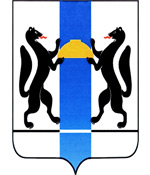
Novosibirsk oblast map, Russia
Novosibirsk oblast latest news and posts from our blog:.
29 November, 2020 / Novosibirsk Akademgorodok - the scientific center of Siberia .
25 December, 2018 / Chuya Highway - the Most Picturesque Road in Russia .
18 September, 2018 / Novosibirsk - the view from above .
10 December, 2014 / The night views of Novosibirsk .
17 July, 2014 / Novosibirsk hit by a heavy hailstorm .
More posts..
History of Novosibirsk Oblast
Over thousands of years, the territory of the Novosibirsk region, due to its location on the border of natural zones and cultural regions (the Siberian taiga and the Eurasian steppe), played the role of a buffer zone or border zone of different peoples.
In the 13th-15th centuries, this land was the eastern outskirts of the Golden Horde. Later, until the end of the 16th century, it was part of the Siberian Khanate. In the 18th century, the territory of the present Novosibirsk region became part of the Russian Empire.
Despite the relatively favorable climate, the Russians began to settle here relatively late. The Barabin Tatars were the indigenous people. Today, their total population is about 10,000 people living mainly in the western parts of the region.
The Barabin Tatars were subjected to constant attacks of the Kalmyks (the Oyrates and Teleuts). Russian villages were also under the threat. That’s why people preferred to settle in the north, near Tomsk. Only at the end of the 17th century, Novosibirsk province became attractive to settlers.
More Historical Facts…
The first settlement was founded by the boyar son Alexey Kruglik in 1695. Later, this settlement became the village of Kruglikovo. Today, it is located in Bolotninsky district. In the early 18th century, Berdsky stockaded town was built. Over time, the threat from the nomads decreased and the number of settlers increased.
In 1722, the Siberian line of fortresses along the Irtysh River was constructed. The locals were mainly engaged in soil tilling, fishing and hunting. In the early 19th century, the famous Ural manufacturer Akinfiy Demidov constructed two copper melting plants here - Kolyvansky and Barnaulsky.
In 1893, due to the construction of the Trans-Siberian Railway and the railway bridge across the Ob River, Alexandrovsky settlement was built (from 1895 - Novonikolayevsky). Thanks to its convenient geographical location (the Trans-Siberian Railway crossing the Ob River, transportation ways connecting Siberia with the European part of the Russian Empire), its trade importance grew rapidly. In 1909, Novonikolayevsk became a town. In 1925, it was renamed in Novosibirsk.
Before 1921, the territory of Novosibirsk oblast was part of Tomsk gubernia, from 1921 to 1925 - of Novonikolayevsk gubernia, from 1925 to 1930 - of Siberian krai, from 1930 to 1937 - of West Siberian krai. September 28, 1937, West Siberian krai was divided into Novosibirsk oblast and Altay krai. This date is considered the official date of the region formation.

Novosibirsk Oblast - Features
Novosibirsk Oblast is located in the south east of the East-Siberian Plain, in the steppe, forest-steppe and taiga zones, between the Ob and the Irtysh rivers. The length of the region from west to east - 642 km, from north to south - 444 km.
The southern part of Vasyugan swamp, the largest swamp in the world, occupies the territory in the north and north-west of the province. In the southwest, it borders with Pavlodar oblast of Kazakhstan.
There are about 3,000 lakes on the territory of the Novosibirsk region. The largest lakes are Chany, Ubinskoye, Sartlan. Novosibirsk Reservoir also known as “the Ob Sea” (1,082 sq. km.) was created for Novosibirsk Hydroelectric Power Plant.
The climate is continental. The average temperature in January ranges from minus 16 degrees Celsius in the south and minus 20 degrees Celsius in the north. The average temperature in July - plus 18-20 degrees Celsius.
The largest cities and towns are Novosibirsk (1,621,000), Berdsk (103,500), Iskitim (54,700), Kuybishev (43,000). Novosibirsk is one the largest industrial, transport, scientific, and cultural center of Russia, the third most populous city in the country after Moscow and St. Petersburg. It is also the capital of the Siberian Federal District.
In the historical part of Novosibirsk you can find a lot of preserved monuments of the Russian Empire times. The Soviet era is presented by numerous scientific and cultural attractions, as well as beautiful parks.
There are more than 500 deposits of various mineral resources in Novosibirsk Oblast (coal, refractory clay, peat, anthracite). Natural gas and oil fields are located in the north-western part of the region. There are significant reserves of underground thermal and mineral waters. Forests cover about 4 million hectares, more than 20% of the territory.
Novosibirsk Oblast is one of the most industrially developed regions in Siberia (metal processing and machine building, food, power engineering, non-ferrous metallurgy industries). Heavy industries are concentrated in Novosibirsk, Iskitim and Berdsk.
The regional agriculture specializes in the cultivation of grain, potatoes and vegetables. Dairy cattle breeding, poultry farming and beekeeping are developed. The production of flax plays an important role too. Agricultural development of the territory is not high (about 48%). In general, it has about 25% of all agricultural land in Western Siberia.
Novosibirsk oblast of Russia photos
Nature of novosibirsk oblast.
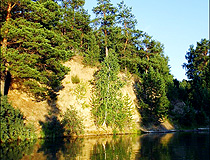
Novosibirsk Oblast nature
Author: Klemeshev
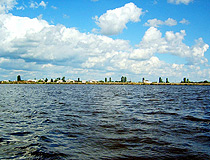
Novosibirsk Oblast scenery
Author: Mikhantiev Zhenya
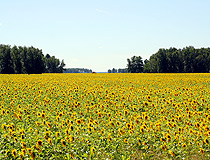
Sunflower field in Novosibirsk Oblast
Author: Sergey Savchak
Pictures of the Novosibirsk region
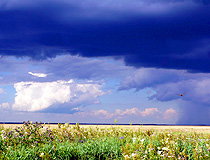
Steppe landscape in Novosibirsk Oblast
Author: Alex Strekhletov
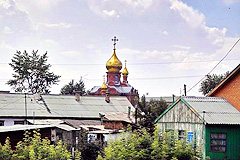
Orthodox church in the Novosibirsk region
Author: Sergey Bulanov
- Currently 3.07/5
Rating: 3.1 /5 (174 votes cast)
- World Atlas /
- Western Siberia /
- Novosibirsk Oblast /
- Novosibirsk /
- Area around 55° 11' 31" N, 82° 31' 30" E /
Physical Map of Novosibirsk
This is not just a map. It's a piece of the world captured in the image.
The flat physical map represents one of many map types available. Look at Novosibirsk, Novosibirsk Oblast, Western Siberia, Russia from different perspectives.
Get free map for your website. Discover the beauty hidden in the maps. Maphill is more than just a map gallery.
- Free map
- Panoramic 4
Shaded Relief
Maps of novosibirsk.
Maphill is a collection of map images. This physical map of Novosibirsk is one of them. Click on the Detailed button under the image to switch to a more detailed map.
See Novosibirsk from a different perspective.
Each map type has its advantages. No map style is the best. The best is that Maphill lets you look at each place from many different angles.
Sure, this physical map is nice. But there is good chance you will like other map styles even more. Select another style in the above table. See Novosibirsk and Western Siberia from a different view.
What to do when you like this map?
If you like this Novosibirsk, Novosibirsk Oblast, Western Siberia, Russia map, please don't keep it to yourself. Give your friends a chance to see how the world converted to images looks like.
Share this map.
Use the buttons for Facebook, Twitter or Google+ to share a link to this physical map of Novosibirsk. Maphill is the largest map gallery on the web. The number of maps is, however, not the only reason to visit Maphill.
Get map of Novosibirsk for free.
You can embed, print or download the map just like any other image. All Novosibirsk and Western Siberia maps are available in a common image format. Free images are available under Free map link located above the map.
Is there anything more than this map?
Sure, there is. It has been said that Maphill maps are worth a thousand words. No doubt about that. But you can experience much more when you visit Novosibirsk.
Be inspired.
Western Siberia has a lot to offer. Each place is different. Each place is worth a visit. It will never be possible to capture all the beauty in the map.
Novosibirsk hotel deals.
If any of Maphill's maps inspire you to come to Novosibirsk, we would like to offer you access to wide selection of nearby hotels at low prices and with great customer service.
Thanks to our partnership with Booking.com you can take advantage of up to 50% discounts for hotels in many locations in the area of Western Siberia. Book hotels online and save money.
Novosibirsk hotels
See the full list of hotels in or close to Novosibirsk , the list of destinations in Novosibirsk , browse destinations in Novosibirsk Oblast , Western Siberia , Russia , Asia or choose from the below listed cities.
- Novosibirsk hotels »
- Hotels in Novosibirsk »
- Hotels in Novosibirsk Oblast »
- Hotels in Western Siberia »
- Hotels in Russia »
- Hotels in Asia »
Hotels in popular destinations in Novosibirsk
- Novolugovoye hotels »
- Kar'yer Mochishche hotels »
- Sadovyy hotels »
- Zavodskaya hotels »
- Matveyevka hotels »
- Pashino hotels »
- Nizhnyaya Yel'tsovka hotels »
- Michurino hotels »
- Berëzovyy Log hotels »
- Chemskiy hotels »
- Ozërnyy hotels »
- Cherbus' hotels »
- Katkovo hotels »
- Mochishche hotels »
Learn more about the map styles
Each map type offers different information and each map style is designed for a different purpose. Read about the styles and map projection used in the above map (Physical Map of Novosibirsk).
Physical map
Physical map illustrates the mountains, lowlands, oceans, lakes and rivers and other physical landscape features of Novosibirsk. Differences in land elevations relative to the sea level are represented by color.
Green color represents lower elevations, orange or brown indicate higher elevations, shades of grey are used for the highest mountain ranges in the world. Underwater topography is represented by blues. Darker blues are used for the deepest water, lighter shades of blue represent shallower water such as the continental shelf.
Geographic map projection
A map projection is a way how to transform points on a Earth to points on a map. This map of Novosibirsk uses Plate Carree projection. The Plate Carree projection is a simple cylindrical projection originated in the ancient times. It has straight and equally spaced meridians and parallels that meet at right angles.
All projections from a sphere to a plane are distorted. The drawback of the Plate Carree projection is that it doesn't make an attempt to compensate for these distortions. For the general view of Novosibirsk, this is not a significant problem. The detailed maps use the Mercator projection which preserves the shape of small areas better.
Locations near Novosibirsk
Destinations close to Novosibirsk sorted by distance.
- Zaton 4.7 km
- Bol'shaya Krivoshchëkova 7.2 km
- Kar'yer 8.0 km
- Bugry 8.3 km
- Kar'yer Mochishche 8.5 km
- Ust'-Inya 8.8 km
- Levoberezhniy 9.8 km
- Ozërnyy 10 km
- Kamenka 10 km
- Katkovo 11 km
Popular searches
A list of the most popular locations in Russia as searched by our visitors.
- Ural Mountains
- Kabardino-Balkarian Republic
- Kaliningrad Oblast
- Kursk Oblast
Recent searches
List of the locations in Russia that our users recently searched for.
- Udskaya Guba
- Amur Oblast
- Bagaevskaya
- Pskov Oblast
- Ladozhskoe Ozero
- Republic of Dagestan
The Maphill difference
It's neither this physical map nor any other of the many millions of maps. The value of a map gallery is not determined by the number of pictures, but by the possibility to see the world from many different perspectives.
We unlock the value hidden in the geographic data. Thanks to automating the complex process of turning data into map graphics, we are able to create maps in higher quality, faster and cheaper than was possible before.
Forever free
We created Maphill to make the web a more beautiful place. Without you having to pay for it. Maphill maps are and will always be available for free.
Real Earth data
Do you think the maps are too beautiful not to be painted? No, this is not art. All 2D maps of Novosibirsk are created based on real Earth data. This is how the world looks like.
Easy to use
This map is available in a common image format. You can copy, print or embed the map very easily. Just like any other image.
Different perspectives
The value of Maphill lies in the possibility to look at the same area from several perspectives. Maphill presents the map of Novosibirsk in a wide variety of map types and styles.
Vector quality
We build each map individually with regard to the characteristics of the map area and the chosen graphic style. Maps are assembled and kept in a high resolution vector format throughout the entire process of their creation.
Experience of discovering
Maphill maps will never be as detailed as Google maps or as precise as designed by professional cartographers. Our goal is different. We want to redefine the experience of discovering the world through the maps.
Fast anywhere
Maps are served from a large number of servers spread all over the world. Globally distributed map delivery network ensures low latency and fast loading times, no matter where on Earth you happen to be.
Spread the beauty
Embed the above physical map of Novosibirsk into your website. Enrich your blog with quality map graphics. Make the web a more beautiful place.
Maphill is the web's largest map gallery.
Get a free map for your website. Explore the world. Discover the beauty hidden in the maps.
Map graphics revolution.™
- You are on Realigro website
- Russian Federation
- Novosibirsk Oblast
Map and property price trends for Novosibirsk Oblast
- List your properties
- Estate agents
- Private seller
- Property portals
Preferences
- Publish your free listing
- Rent-holidays
Property ads for Novosibirsk Oblast, Map and property price trends
Page views divided according to country of origin
Change date interval 1 month 2 months 6 months
Price trend (USD/m²)
Search by area.
- Borovoe (1)
- novosibirsk city (1)
Property ads for Novosibirsk Oblast
For a better use of Realigro website, set your preferences for language, currency, square meters or sq ft.

IMAGES
COMMENTS
Tonkin Gulf Yacht Club. The most prevalent version of the logo shows the silhouette of a Vietnamese Junk with the flag of the Republic of Vietnam in background. Tonkin Gulf Yacht Club was a tongue-in-cheek nickname for the United States Seventh Fleet during the Vietnam War. Throughout the War in Vietnam, the Seventh Fleet engaged in combat ...
The Tonkin Gulf Yacht Club was a nickname for the United States Navy Seventh Fleet during the Vietnam War. Throughout the war in Vietnam, the Seventh Fleet engaged in combat operations against enemy forces through attack carrier air strikes, naval gunfire support, amphibious operations, patrol and reconnaissance operations, mine warfare, and ...
Tonkin Gulf Yacht Club Stateroom. During the Vietnam War, U.S. Navy carriers operated off the east coast of North Vietnam in an area called "Yankee Station." The body of water in which the flattops and their escorts steamed was the Gulf of Tonkin, and sailors deployed to the Western Pacific quickly nicknamed this assembly of ships the "Tonkin ...
I wonder if any Đàn elders still tell stories of their encounters with the 7th Fleet Tonkin Gulf Yacht Club. Al Wellman was a Guided Missile (GM) officer who stood Officer of the Deck (OOD) watches aboard a Navy cruiser in the Positive Identification RADAR Advisory Zone (PIRAZ) from 1970 to 1972.
Seventh Fleet represented the first official entrance of the United States into the Vietnam War, with the Gulf of Tonkin incident. Between 1950 and 1970, the U.S. Seventh Fleet was known by the tongue-in-cheek nickname "Tonkin Gulf Yacht Club" since most of the fleet's operations were conducted from the Tonkin Gulf at the time. [ 7][ 8]
Tonkin Gulf Yacht Club was a tongue-in-cheek nickname for the United States Seventh Fleet during the Vietnam War. [1] All through the war in Vietnam, the Seventh Fleet engaged in combat operations against enemy forces through attack carrier air strikes, naval gunfire support, amphibious operations, patrol and reconnaissance operations and mine warfare.
The Tonkin Gulf Yacht Club is titled after the nickname for the US Navy's Seventh Fleet which was stationed off the coast of Vietnam, and it tells the full story of the US Navy's war in the air. It details all the operations from the USS Maddox onwards through to the eventual withdrawal of the fleet following the collapse of South Vietnam in 1975.
The 'Tonkin Gulf Yacht Club' was the tongue-in-cheek nickname of the US Seventh Fleet that was stationed off the coast of Vietnam and tells the full story of the US Naval air campaign in the Vietnam War from 1965 to 1975. On the blog today, author Thomas McKelvey Cleaver discusses the most memorable operation he took part in and whether we should be learning more about The Vietnam War in school.
Tonkin Gulf Yacht Club. Tonkin Gulf Yacht Club. By: Garland Davis. The novel and movie, "Mister Roberts" pictures life aboard a "bucket" that tiresomely traffics between the islands of Tedium and Apathy with side trips to Monotony. This is my story of a WestPac at the end of the war in Vietnam.
This book tells the full story of the US Naval air campaign during the Vietnam War between 1965 to 1975, where the US Seventh Fleet, stationed off the Vietnamese coast, was given the tongue-in-cheek nickname 'The Tonkin Gulf Yacht Club'. On August 2, 1964, USS Maddox became embroiled in the infamous 'Gulf of Tonkin incident' that lead directly to America's increased involvement in the Vietnam ...
THIS IS MUST READ IF YOU WANT TO JOIN: Private. Only members can see who's in the group and what they post. Visible. Anyone can find this group. History. Group created on February 1, 2009. See more.
The Tonkin Gulf Yacht Club was the nickname for the US Navy's Seventh Fleet, Task Force 77, stationed off the coast of Vietnam which, at various points throughout the war, comprised as many as six carriers with 70-100 aircraft on board.
The Tonkin Gulf Yacht Club was the nickname for the US Navy's Seventh Fleet, Task Force 77, stationed off the coast of Vietnam which, at various points throughout the war, comprised as many as six carriers with 70-100 aircraft on board. The Seventh Fleet played an essential role in supporting operations over Vietnam, providing vital air support to combat troops on the ground and taking part ...
This book tells the full story of the US Naval air campaign during the Vietnam War between 1965 to 1975, where the US Seventh Fleet, stationed off the Vietnamese coast, was given the tongue-in-cheek nickname 'The Tonkin Gulf Yacht Club'.On August 2, 1964, USS Maddox became embroiled in the infamous 'Gulf of Tonkin incident' that lead directly to America's increased involvement in the Vietnam ...
The author starkly criticises the premise for war, the August 1964 Gulf of Tonkin 'incident' which he categorically refutes having taken place in the manner relayed back to Washington. Sprinkled throughout the book are hints of the conspiracy theorist as the author compares his research (including oral testimony) to the Pentagon's ...
Happy Saturday all,here is my Navy "Yacht Club" collection. Over the years I have picked up a few of the original Tonkin Gulf ones,in various sizes and shapes,and every now and then,would see one from other places,so I decided to try and collect as many different ones as possible. If anyone has a...
Tonkin Gulf Yacht Club. US Navy sailors serving during Vietnam war in the Western Pacific.
Yacht Club Prestizh, Novosibirsk: See traveler reviews, 3 candid photos, and great deals for Yacht Club Prestizh, ranked #52 of 76 B&Bs / inns in Novosibirsk and rated 5 of 5 at Tripadvisor.
The Tonkin Gulf Yacht Club was the nickname for the US Navy's Seventh Fleet, Task Force 77, stationed off the coast of Vietnam which, at various points throughout the war, comprised as many as six carriers with 70-100 aircraft on board. The Seventh Fleet played an essential role in supporting operations over Vietnam, providing vital air support to combat troops on the ground and taking part ...
Novosibirsk Oblast - Overview Novosibirsk Oblast is a federal subject of Russia, part of the Siberian Federal District. Novosibirsk is the capital city of the region.
The flat physical map represents one of many map types available. Look at Novosibirsk, Novosibirsk Oblast, Western Siberia, Russia from different perspectives.
The Tonkin Gulf Yacht Club Q&A. Was the Gulf of Tonkin Incident a false pretext for the US escalation of the Vietnam War? It is a "false pretext" in that the Tonkin Gulf Resolution the Congress passed as a result, which was used as a "de facto declaration of war" by the Administration, was the result of inaccurate reporting, which the ...
Property ads for Novosibirsk Oblast, Map and property price trends This page shows a Map of properties for sale or to rent in Novosibirsk Oblast, the trends for prices of properties sold or rented and the statistics for page views in Novosibirsk Oblast, divided according to country of origin.